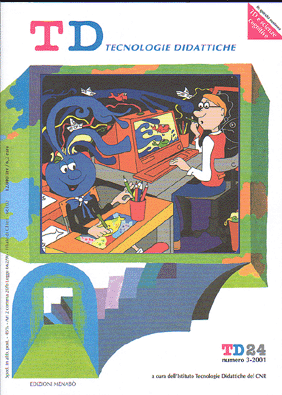Discussion and argument in a university forum
Main Article Content
Abstract
Article Details
Authors who publish with this journal agree to the following terms:
- Authors retain copyright and grant the journal right of first publication with the work simultaneously licensed under a Creative Commons CC BY 4.0 Attribution 4.0 International License.
- Authors are able to enter into separate, additional contractual arrangements for the non-exclusive distribution of the journal's published version of the work (e.g., post it to an institutional repository or publish it in a book), with an acknowledgement of its initial publication in this journal.
- Authors are permitted and encouraged to post their work online (e.g., in institutional repositories or on their website) prior to and during the submission process, as it can lead to productive exchanges, as well as earlier and greater citation of published work (See The Effect of Open Access)
References
Bielaczyc K. (2001), Designing social infrastructure: The challenge of Building Computer-Supported Learning Communities, in Proceedings of the Euro-CSCL 2001 Conference, March 22- 24, Maastricht, The Netherlands, pp. 106- 114.
Calvani A., Sorzio P., Varisco B. M. (1997), Uno studio esplorativo di apprendimento cooperativo a distanza, TD - Tecnologie Didattiche, vol. 12, pp. 27-33.
Donath J., Karahalios K., Viégas F. (1999), Visualizing conversation, Journal of Computer Mediated Communication, 4 (4),http://www.ascusc. org/jcmc/vol4/issue4 donath.html.
Hakkarainen K., Sintonen M. (2001), The interrogative model of inquiry and computer supported collaborative learning, Science & Education (in stampa).
Jerman P., Soller A., Muehlenbrock M. (2001), From mirroring to guiding: a review of the State of the Art Technology for supporting Collaborative Learning, in Proceedings of the Euro-CSCL 2001 Conference, March 22-24, Maastricht, The Netherlands, pp. 324- 331.
Lakkala M., Syri J., Lallimo J., Palonen, T., Hakkarainen K. (2001), New learning culture to school? Evaluating a virtual learning project in lower secondary school, in Proceedings of 9th European Conference for Research on Learning and Instruction, 28 agosto - 1 settembre 2001, Friburgo, Svizzera.
Lave J., Wenger E. (1991), Situated learning: Legitimate Peripheral Participation, Cambridge University Press, Cambridge.
Lethinen E., Hakkarainen K., Lipponen L., Rahikainen M., Muukkonen, H. (1999), Computer Supported Collaborative Learning: A review of research and development, in The J.H.G.I. Gisberg Report on Education, 10, University of Nijmegen, Department of Educational Sciences, Netherlands.
Ligorio M.B., Cesareni D., Mancini I., Talamo A. (2001), Collaboration, constructivism, and community: the three “C” for the CSCL in Italy, Deliverable for the ITCOLE project.
Martini F. (2001), Apprendimento collaborativo in rete fra studenti universitari, tesi di laurea, Facoltà di Psicologia, Università di Roma “La Sapienza”.
Muukkonen H., Hakkarainen K., Lakkala, M. (1999), Collaborative technology for facilitating Progressive Inquiry: The future Learning Environment tools, in Hoadley C. e Roschelle J. (eds) Proceedings of the CSCL ’99 conference, December 12-15, 1999, Palo Alto, pp. 406-415, Lawrence Erlbaum and Associates, Mahwah, NJ.
Orsolini M., Pontecorvo C. (1992), Children’s talking in classroom discussions, Cognition and Instruction, 9 (2), pp. 113-136.
Pèrez A. J., Mugny G. (1993), Influences sociales. La théorie de l’elaboration du conflict, Delachau et Niestlè, Laussanne, CH.
Pontecorvo C., Girardet H., Zucchermaglio C. (1993), Forme di ragionamento condiviso nella comprensione di argomenti storici, in Pontecorvo C. (a cura di) La condivisione della conoscenza, La Nuova Italia, Firenze, pp. 207-265.
Resnick L..B., Salmon M., Zeitz C. M., Haley Wathen S., Holowchak M. (1993), Reasoning in conversation, Cognition and Instruction, 11 (3 e 4), pp. 347-364.
Scardamalia M., Bereiter C. (1992), An Architecture for Collaborative Knowledge Building, in De Corte et al (eds), Computer Based Learning Environments, Springer Verlag, Berlin, pp. 41-67.
Scardamalia M., Bereiter C. (1993), Technologies for knowledge-building discourse, Communication of the ACM, 36 (5), pp. 37-41.
Scardamalia M., Bereiter, C. (1994), Computer support for knowledgebuilding communities, The Journal of the Learning Sciences, vol. 3, pp. 265-283.
Wilson T., Whitelock D. (1997), Come lo hanno usato? Il coinvolgimento degli studenti di informatica in un ambiente CMC creato per l’apprendimento a distanza, TD - Tecnologie didattiche, vol. 12, pp. 15-20.

